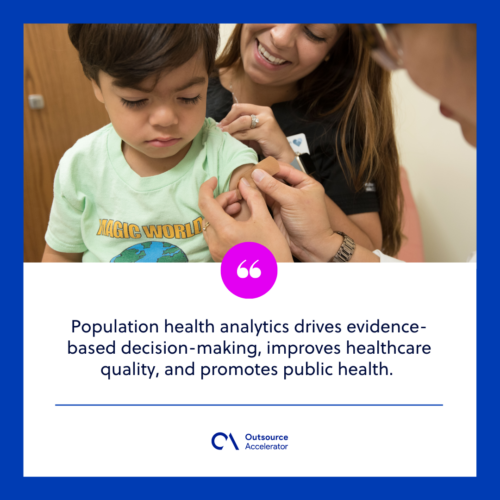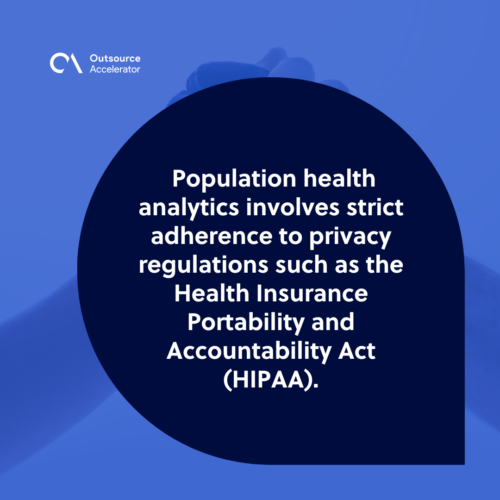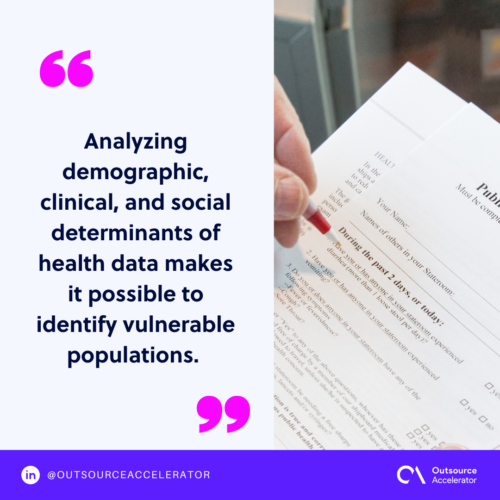Population health analytics: Data-driven insights for healthcare improvement

Gone are the days when the only option for healthcare providers to gain information was to comb through hundreds of paper documents. Data can now be analyzed on a mass scale, which opens ways to move forward in social health.
Population health analytics is one outcome of this. With so much health data available today, this analytics provides the means to unlock valuable insights and drive evidence-based decision-making.
What is population health analytics?
Population health analytics is the application of data analysis and statistical methods to large sets of health data from a population. Its goal is to identify patterns, trends, and associations that will inform decision-making to improve that population’s overall health.
Population health analytics drives evidence-based decision-making, improves healthcare quality, and promotes public health. It enables healthcare providers and stakeholders to identify and address health issues at both individual and population levels.

How is population health data collected?
Data for population health analytics is collected through various methods. This healthcare data is mined to gain insights into a specific population’s health status, behaviors, and outcomes.
The following are common approaches for collecting population health data:
Surveys and questionnaires
Surveys and questionnaires are used to collect self-reported information from individuals or households. These can include questions about health conditions, lifestyle habits, healthcare access, and utilization.
Electronic health records (EHRs)
Electronic health records contain medical and health information collected by healthcare providers during patient visits.
EHRs capture data such as diagnoses, treatments, medications, laboratory results, and demographics. Aggregating EHR data can provide a comprehensive view of a population’s health.
Administrative data
Administrative data sources provide valuable information on healthcare utilization, costs, and procedures performed. These data sources are often used to analyze population-level patterns and trends.
Administrative data includes:
- Insurance claims
- Billing records
- Hospital discharge records
Vital statistics and registries
Vital statistics data provide demographic and health-related information about a population. They include birth and death records.
Disease registries collect specific data on individuals diagnosed with particular diseases or conditions.
Biometric and wearable devices
With the advancement of technology, biometric devices, and wearables can collect real-time health data. They’re most commonly in the form of fitness trackers or smartwatches.
These devices monitor physical activity, heart rate, sleep patterns, and other biometric measurements, offering valuable insights into individual and population health.
Social determinants of health (SDOH) data
Social determinants of health data capture information about non-medical factors influencing health outcomes.
This covers:
- Socioeconomic status
- Education
- Housing
- Environmental conditions
This data can be collected through surveys, administrative records, or community assessments.
Epidemiological studies and clinical trials
Research studies, including epidemiological studies and clinical trials, collect data on a specific population. They aim to understand disease prevalence, risk factors, treatment efficacy, and health outcomes.
These studies provide valuable population health data for analysis and decision-making.
Challenges involved with population health analytics
Population health analytics faces several challenges that can impact its implementation and effectiveness.
Data quality and interoperability issues
Data quality and reliability are crucial for accurate population health analytics. These issues can take the following forms:
- Inaccurate or incomplete data – Data inconsistencies, missing values, and errors can hinder the reliability of population health analytics outcomes.
- Lack of standardization – Population health analytics is collected using different formats and standards from various sources. This makes it challenging to integrate and analyze data effectively.
- Limited interoperability – Health systems and EHR platforms may not communicate or share data seamlessly, impeding the ability to create a holistic view of population health analytics.
Privacy and security concerns
Population health analytics deals with sensitive patient information. Organizations must ensure rigid protection.
- Protected health information (PHI) – Population health analytics involves strict adherence to privacy regulations such as the Health Insurance Portability and Accountability Act (HIPAA). Ensuring data security and protecting patient privacy can be complex and resource-intensive.
- Data breaches and cyber threats – The digitization of healthcare data introduces the risk of data breaches and cyberattacks. These potentially compromise the privacy and security of population health analytics.

Resource constraints and technical barriers
Implementing population health analytics requires substantial resources, including financial investment, technological infrastructure, and skilled personnel.
- Limited funding – Many healthcare organizations face budgetary constraints, making it difficult to invest adequately in necessary resources.
- Technical expertise and training – The shortage of professionals with data and analytics skills poses a challenge to leverage the potential of population health analytics fully.
- Technological limitations – Outdated or incompatible technology infrastructure can hinder the collection, storage, and analysis of large-scale population health data. Upgrading systems and ensuring compatibility can be costly and time-consuming.
Ethical and legal considerations
Population health analytics raises ethical questions regarding data ownership, consent, and the responsible use of data.
- Data ownership and consent – Determining ownership and consent for population health data can be complex. Balancing individual privacy rights with the societal benefits of population health analytics requires careful ethical considerations.
- Legal and regulatory landscape – Compliance with evolving data protection laws adds complexity and legal obligations to population health analytics initiatives. Examples of laws include the general data protection regulation (GDPR) and emerging regulations specific to health data.
Bias and equity issues
Bias within population health data can perpetuate health disparities and inequities.
- Data bias – Population health analytics heavily relies on historical data, which may reflect existing biases and disparities in healthcare delivery. This can lead to inaccurate conclusions, impacting decision-making and resource allocation.
- Health disparities – Accessing and incorporating data on social determinants of health can be challenging, limiting the ability to fully understand and address health inequities.
Benefits of population health analytics
Population health analytics offers numerous benefits in improving healthcare outcomes and promoting public health.
Some of the key advantages include:
Identifying health trends and patterns
Population health analytics helps identify health trends and patterns within a specific population or across multiple populations.
Analyzing large datasets makes it possible to detect disease outbreaks, determine risk factors, and monitor the prevalence of certain health conditions. This information helps in understanding population health dynamics and designing targeted interventions.
Predictive modeling for disease prevention and intervention
This type of data analytics utilizes predictive modeling techniques to forecast health outcomes and identify individuals at high risk of developing certain diseases. Predictive models can help healthcare providers proactively intervene with preventive measures.
This approach improves early detection, disease prevention, and the allocation of resources for high-risk populations.
Assessing the impact of interventions and healthcare policies
Population health analytics allows for the evaluation of interventions, healthcare policies, and public health programs. By comparing health outcomes before and after implementing specific interventions, it becomes possible to assess their effectiveness.
This evaluation helps in making data-driven decisions about which interventions are successful, which can guide future policy development and resource allocation.
Targeted interventions for high-risk populations
With population health analytics, healthcare organizations can identify high-risk populations that require targeted interventions and resources. Analyzing demographic, clinical, and social determinants of health data makes it possible to identify vulnerable populations.
Targeted interventions can then be developed to address the specific needs of these populations, leading to improved health outcomes and reduced disparities.

Evaluating healthcare outcomes and performance metrics
Population health analytics provides a means to evaluate healthcare outcomes and performance metrics at both the individual and population levels.
Healthcare organizations can assess their performance and identify areas for improvement by analyzing healthcare utilization data. This evaluation supports evidence-based decision-making, quality improvement initiatives, and the delivery of value-based care.
Resource allocation and planning
Population health analytics plays a vital role in resource allocation and healthcare planning. Healthcare organizations can identify areas with high healthcare needs, allocate resources accordingly, and optimize service delivery.
This approach helps in reducing healthcare costs, improving resource utilization, and ensuring that the right services are provided to the right populations.







 Independent
Independent




